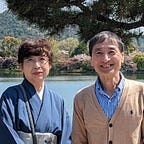An Intimate Exploration into Kyoto: Serene Solitudes & Timeless Tales
— Article 16: Tofukuji in Spring —
On May 15, 2020, I had the opportunity to visit Tofukuji Temple, a historic site established in the 13th century. Renowned as one of the five great temples of Kyoto, its architectural and cultural significance is profound.
The approach to Tofukuji is marked by the Gaunkyo Bridge, offering a picturesque view of the Tsutenkyo Bridge, gracefully arching over the temple’s central garden nestled in a valley below. As I meandered through the six meticulously curated gardens of Tofukuji, the interplay of architecture and nature was striking. From the vantage point of the Tsutenkyo Bridge, the Gaunkyo appeared almost ethereal, floating atop a sea of leaflets. The Kaizando, a shrine dedicated to the temple’s founding priest, is flanked by yet another serene garden.
Notably, the Sanmon Gate, dating back to the 15th century, exemplifies architectural mastery. Its structure is not only aesthetically pleasing but also a testament to the intricate woodcraft techniques of the era, as evident in the accompanying photographs. The Yokushitsu, a sauna constructed in the same century, is Japan’s second-oldest monastic bathhouse. A comparison with the autumnal images of Tofukuji, as depicted in my second article, reveals the temple’s seasonal transformations.
Fundain, a sub-temple within the Tofukuji complex, dates back to the 14th century. It was a beloved retreat of Sesshu, a master painter. The Tsurukame Garden, originally conceptualized by Sesshu and later restored by Mirei Shigemori in the mid-20th century, offers a tranquil space that harmoniously blends historical design with contemporary aesthetics. The view of the Higashi Garden from the tea room was particularly enchanting.
For those yet to experience the serene beauty of Kyoto, I recommend starting with the first article in this series, “An Intimate Exploration into Kyoto: Serene Solitudes & Timeless Tales — Article 1: Lesser Known Gems.”
Stay tuned for the forthcoming article, “Leaflets in North Saga,” as we continue to traverse the lesser-known yet captivating landscapes of Kyoto.
